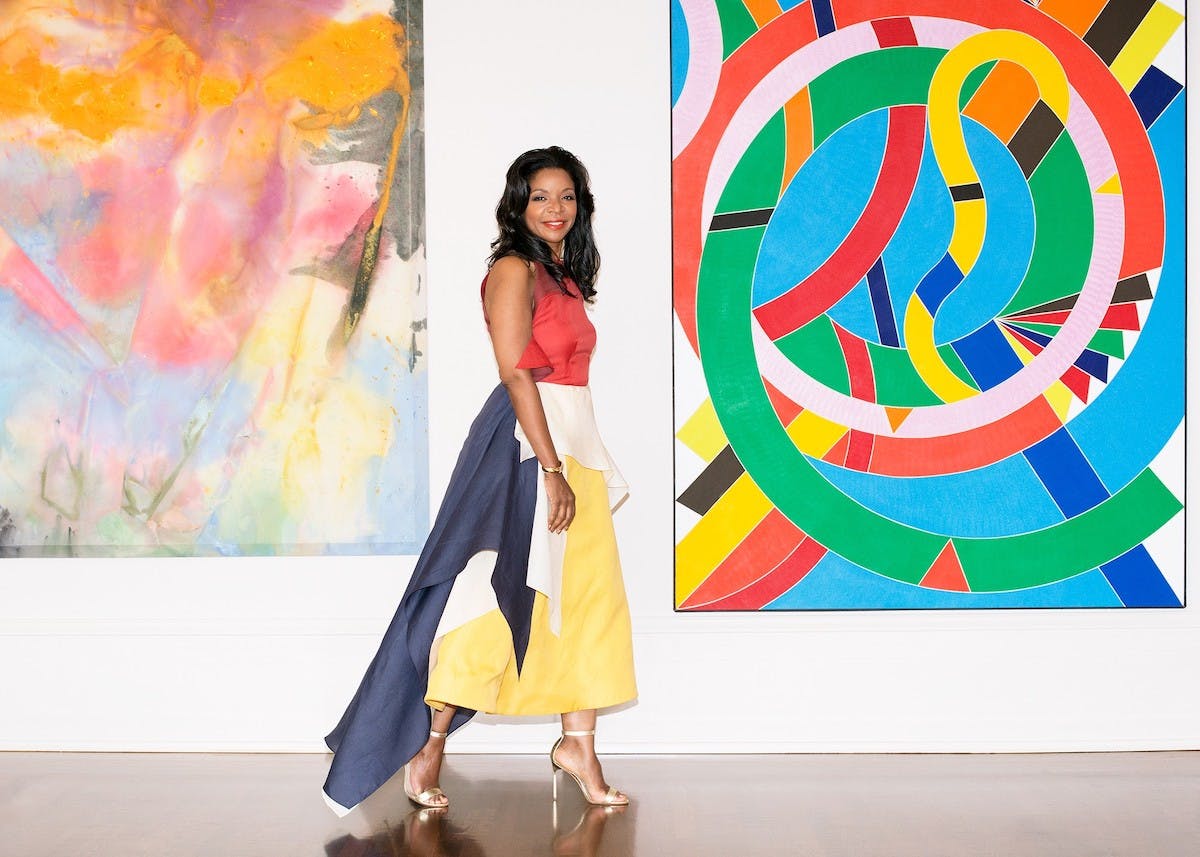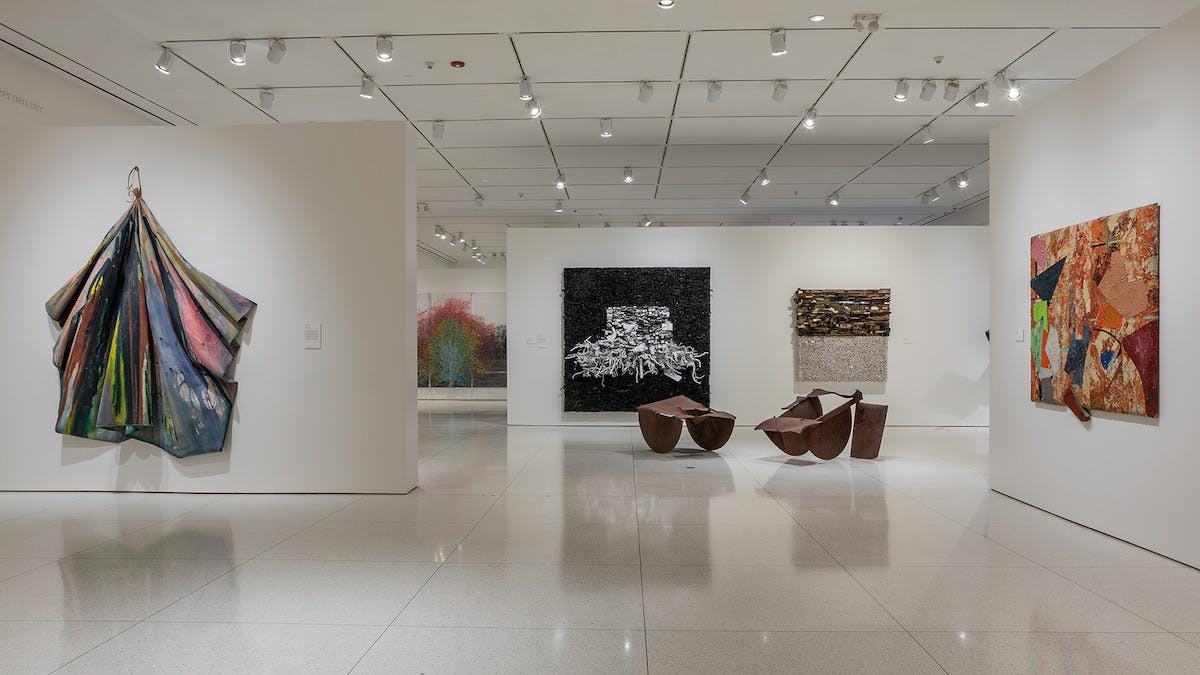Pamela J. Joyner: an activist collector reframing art history

For more than twenty years, San Francisco-based contemporary art collector Pamela J. Joyner has supported and promoted the works of African-American artists and artists of the modern African diaspora. With her husband, Alfred J. Giuffrida, the couple has built a collection of more than 400 works, mainly abstract paintings, that were collected to help rewrite the role artists of color have played in art history. This post explores Joyner’s structured, academic-oriented, and mission-driven collecting practice and the active role she plays in many art museums around the world.
Who are Pamela J. Joyner and Alfred J. Giuffrida?
Pamela Joyner was born in Chicago to a family that exposed her to art and music at a very early age. She actually took a year off from Harvard, where she earned an M.B.A, to tour as a professional ballerina. After finishing college, she worked in the finance sector focusing on marketing services for private equity firms. Through a very successful career, she became a founding partner of Avid Partners LLC, a strategic marketing consulting firm, and previously held senior positions at Bowman Capital Management LLC and Capital Guardian Trust Company. Nowadays, she serves on the board of directors for Apollo Global Management, Inc.
Joyner’s husband, Alfred J. Giuffrida studied at Notre Dame and received a Law degree from Harvard. Giuffrida worked in private equity and currently serves as Managing Director for Horsley Bridge Partners in San Francisco. Without a doubt, this is a highly cultured business power couple.
How the Joyner/Giuffrida collection turned into a mission-driven endeavor
While Pamela has always been fond of art, she credits Lowery Sims, former curator at The Metropolitan Museum of Art and the first black curator to hold that title, for inspiring her to collect art and support the work of black artists. “After meeting art historian and curator Lowery Sims, I understood that there was an issue to be addressed, so I started with careers in that genre,” she said in an interview with Architectural Digest.
As what she refers to as her learning curve, Pamela surrounded herself with experts and mentors, including Sims, to help introduce her to work by black artists. Here, we should remember Joyner was already knowledgeable in art mainly due to her frequent assistance to all sorts of art exhibitions from a young age.
Starting in the 1990s, Pamela first acquired a few artworks “to fill her walls,” but then focused solely on pieces by African-American abstract post-war and contemporary artists. In the beginning, this process was intended to create a different perspective for viewing art, at least in the privacy of her own home. However, in the early 2000s, Joyner, by then married to Giuffrida, turned her collecting practice into a mission-driven endeavor that sought to help artists and institutions rectify the void created by a lack of representation and recognition for works of black artists. “Ours is a mission-driven collection with no smaller ambition than to reframe art history and make certain, to the extent of our capabilities and resources, that our artists are put into the full context of a diverse canon,” Joyner said in 2016 to a TEDx audience in South Africa.
In recent years, the collection’s focus has expanded to include artists from Africa and the global African diaspora. For example, in 2021, the couple began to focus on Afro-Brazilian artists. In an interview with Architectural Digest, Pamela is quoted as saying: “Brazil is such a complex society that thinks of itself as post-racial, but there are so many artists of color who’ve never been a part of the mainstream there—Rubem Valentim and Emanoel Araujo are two such touchstones for us.” Importantly, while the collection has a majority of works by artists of color, not all of the artists in this collection are identified as black, as it also holds works by South African artists like William Kentridge. Pamela’s logic behind this choice is her belief that a collection should not only be about skin color but about supporting a community of artists that have been previously overlooked.
Now, Pamela is not your everyday collector as she has a disciplined and structured approach to art collecting, often developing short and long-term plans for her acquisitions. Joyner credits her background in finance as the influence for this practice. “I make the rules and I break them,” she once said.
A collection of abstract visionary artists
For years, Joyner has been drawn to analyze how, during the civil rights movement, black artists were encouraged to make figurative work that depicted African American uplift, but they, in turn, wanted to experiment and did so mainly through abstraction. During these years black artists founded collectives, such as the New-York based Spiral, where they discussed their relationship with the civil rights movement and the shifting landscape of American culture. At the same time, Pamela views abstraction as pivotal to her collecting practice given she thinks it has a universal and disruptive nature that can be applied to different contexts. “There is something freeing about abstraction,” she said in this podcast with Collect Wisely.
As shared by Pamela, the turbulent context of the mid-20th century resulted in black artists innovating in terms of formats, mediums, and techniques but receiving little, if any recognition, because the mainstream wanted the artists to create art that was “clearly and identifiably black.” In this interview, the collector cites the work of Ed Clark, who is now recognized as the first artist in the modern era to work on shaped canvases. More so, Jack Whitten also did squeegee paintings in the 1970s, at least a decade before Gerhard Richter. And, Sam Gilliam innovated with his monumental drape paintings.
As of this date, the Joyner/Giuffrida collection encompasses more than 400 artworks by artists such as Alma Thomas, Mark Bradford, Firelei Báez, Romare Bearden, Kevin Beasley, Zander Blom, David Hammons, Isaac Julien, Jacob Lawrence, Glenn Ligon, Julie Mehretu, Oscar Murillo, Christina Quarles, Robin Rhode, Lorna Simpson, Shinique Smith, Kara Walker, Lynette Yiadom-Boakye and many others. Importantly, as the collection also intends to document the careers of artists, it includes significant holdings of works by artists such as Sam Gilliam, Frank Bowling, Norman Lewis, Leonardo Drew, and Jack Whitten.
Notably, alongside their collecting practice, the couple has also run an artist residency program in Sonoma since 2014. Among the established and emerging figures who have visited there, are Leonardo Drew, Lorna Simpson, Hilton Als, and Andrianna Campbell-LaFleur, the last of whom, as stated by ARTnews, spent three months on her doctoral research related to Norman Lewis and Abstract Expressionism. Aligning with their interest in spending time with creative minds, the residency program is located close to the couple’s main residence which allows them to interact with the artist working or, on occasion, relaxing in the 3,000-square-foot home with a proper studio.
Showcasing the collection: catalog, exhibition, and museum-like home

While the couple is not interested in opening an exhibition space, they have documented their collection extensively by providing a scholarly framework for it, something not commonly practiced by other collectors. For instance, in 2016, their pursuit was chronicled in the book Four Generations: The Joyner/Giuffrida Collection of Abstract Art (Gregory R. Miller & Co.), which has since been updated to incorporate new works. The book served as the introduction to Solidary & Solitary: The Joyner/Giuffrida Collection, a popular traveling exhibition that debuted in 2017 at the Ogden Museum of Southern Art in New Orleans. As reported by Architectural Digest, the exhibition has since then been housed in four more institutions before ending in 2020. Seeking to be more than just a show of artists linked together by race, the exhibition offered a new perspective on the critical contributions that artists of African descent have had on the evolution of abstract art from the 1940s to the present.
Next to these books and exhibitions, the couple displays works from their collection in their residences in San Francisco, Sonoma, and New York and frequently organizes events for people to enjoy their collection, as mentioned in their profile for the Art News’ Top 200 Collectors. Particularly, the couple’s four story- mansion in San Francisco, is filled with nearly 150 pieces from their collection.
As detailed in this Architectural Digest article, their main residence was initially decorated by Houston-based designer Philip Sheffield, who has since adapted the design over the years to incorporate the couple’s ever-growing collection. “What we sit on in the home is now a function of what hangs on the walls,” Joyner said, adding, “I feel like I’m perpetually redecorating, mostly because I have to get rid of furniture or reconfigure it oddly.” The rest of the collection is either in storage or on loan to museums.
Joyner’s involvement with art museums and art collectors
As one would expect, Joyner has played a very active role within the museum world and has sat on different museum boardsaround the world. For example, she has collaborated with the Tate Modern, in London, to fill the gap that the museum had in terms of African-American art and holds seats on the boards of the Tate Americas Foundation and the Art Institute of Chicago. At the same time, she also serves on the board of advisers of Mark Bradford’s nonprofit organization, Art + Practice, and the painting and sculpture committee of MoMA New York.
Pamela is also a trustee of the J. Paul Getty Trust, and the San Francisco Museum of Modern Art, the latter to which Joyner and Giuffrida have donated 31 works by 20 American artists such as Elizabeth Catlett, Beauford Delaney, Norman Lewis, and Richard Mayhew. As Pamela mentions in her profile for Art Review’s Power 100 list, she selected these works to help plug a gap in SFMOMA’s collection. Joyner said about this gift: “What I want visitors to take away is that there were people of color not only working in the field,” adding, “but defining the character of the movement at that time.’
Next to her close relationship with many museums, Joyner is also a mentor for many other collectors, such as Komal Shah, who have been inspired by her vision. As recounted in this ARTnews article, when providing advice to collectors starting in the field, Joyner often tells them: “Figure out where the vacuum is, where the void is, where the need is. So, whatever the void is, find the need and fill the gap.” Always keen to acknowledge the work of the many artists, curators, museum people, or fellow collectors whom she constantly works with (she rarely uses the pronoun I), Joyner considers she is also constantly learning from her colleagues.
Pamela once shared that she used to receive visitors to her house by saying: “These walls are filled with artists you’ve never heard of.” Fast-forward in time, much has changed and, thanks to Pamela’s relentless drive and to the work of many others supporting black artists, nowadays many artists’ works that hang on her walls are internationally known.